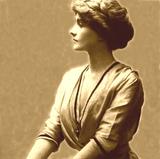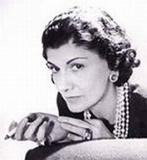Coco Chanel was a French fashion designer whose pursuit of expensive simplicity made her rich. She was the founder of one of the most famous fashion brands, 'Chanel', but it didn't start out like this, oh no, there was a rocky road to fame, which features many moments she wouldn't be proud of. She was the second daughter an illiterate market stallholder and an equally illiterate laundrywoman and this illiteracy later proved to be a blessing to our heroine as neither of them could confirm the correct spelling of the surname to the hospital and it was recorded by the mayor François Poitou as "Chasnel".
This misspelling made the tracing of her roots almost impossible for early biographers when Chanel later rose to prominence (Later in life, she concocted an elaborate false history for her humble beginnings. Chanel would steadfastly claim that when her mother died, her father sailed for America to get rich and she was sent to live with two cold-hearted spinster aunts. She even claimed to have been born in 1893 as opposed to 1883, and that her mother had died when Coco was two instead of twelve)....

Her mother died and her father abandoned the children and the young Chanel spent six years in a Catholic orphanage of the Roman Catholic, where she learned the trade of a seamstress until when she turned eighteen, she was obliged to leave the orphanage and find a job.
She affiliated with the circus of Moulins as a
cabaret singer (Chanteuse). She performed in bars in Vichy and Moulins where she was known as "
Coco". Chanel later said that it was a "
shortened version of coquette, the French word for 'kept women," according to an article in 'The Atlantic'. However the dream of being a singer failed when she couldn't get steady work as a singer, and she started designing hats 'as a hobby' ... she became a licensed modiste (hat maker) in 1910, and she eventually found a backer and opened her first boutique at 21 rue Cambon, Paris named 'Chanel Modes' and her backers own clothing style, notably his English jersey blazers, inspired her creation of the 'Chanel Look'. Chanel's modiste career bloomed once theatre actress Gabrielle Dorziat modelled her hats in the play 'Bel Ami' in 1912 (Subsequently, Dorizat modelled her hats again in Les Modes) and by 1919, Chanel was registered as a couturiere and established her maison de couture at 31 rue Cambon
In 1924, Chanel made an agreement with the Wertheimer brothers, Pierre and Paul, to create a corporate entity, "Parfums Chanel." The Wertheimers agreed to provide full financing for production, marketing and distribution of Chanel No. 5. For ten percent of the stock, Chanel licensed her name to "Parfums Chanel" and removed herself from involvement in all business operations ... she then spent years trying to get control back .... she did so by getting the German officials to legalize her right to sole ownership, because the Wertheimers, were Jewish and had fled France, and Chanel used her position as an “Aryan” to try and get them removed during the occupation of France

Ultimately, the Wertheimers and Chanel came to a mutual accommodation, re-negotiating the original 1924 contract to her benefit (they had put a Christian in charge during the war, which stopped her original claim).
In 1931 Chanel met movie mogul Samuel Goldwyn who offered Chanel the sum of a million dollars (approximately seventy-five million today), to go to Hollywood twice a year to design costumes for MGM stars. Chanel accepted the offer. En route to California from New York traveling in a white train car, which had been luxuriously outfitted specifically for her use, she was interviewed by Colliers magazine in 1932. Chanel said she had agreed to the arrangement to "
see what the pictures have to offer me and what I have to offer the pictures" ...
not the money then  Collaborator
Collaborator:
In 1939, at the beginning of World War II, Chanel closed her shops. She believed that it was not a time for fashion but she didn't leave France. During the German occupation Chanel resided at the Hotel Ritz, which was also noteworthy for being the preferred place of residence for upper echelon German military staff. She also maintained an apartment above her couture house at 31 rue Cambon.
Chanel’s friend and biographer Marcel Haedrich provided a telling estimation of her wartime interaction with the Nazi regime: “
If one took seriously the few disclosures that Mademoiselle Chanel allowed herself to make about those black years of the occupation, one’s teeth would be set on edge.” ... just today fresh allegations by biographer Hal Vaughan state that Chanel
actually worked for German military intelligence during the war.
Whilst not a spy, she was a collaborator "
She was a facilitator. She knew everybody in Spain, she knew everybody in England, and she helped out the Nazis." In 1945, she moved to Switzerland, (possibly to avoid the collaboration trials). There are some suggestions that she was only spared from being tried as a collaborator due to either Churchill's intervention, or as others say because of the British Royal Family intervening.
Post War:
On 17 May 1947, Chanel received wartime profits of Chanel No. 5 in the amount of some nine million dollars in today’s money, and in the future her share would be two percent of all Chanel No. 5 sales worldwide. The financial benefit to her would be earnings of twenty-five million dollars a year, making her at the time one of the richest women in the world.
She finally returned to Paris in 1954 when the collaborations offences were no longer a public thirst ... That same year she returned to the fashion world. Oddly the re-establishment of her couture house in 1954 was fully financed by Chanel’s old nemesis in the perfume battle, Pierre Wertheimer. The price of this was to allow Wertheimer to maintain ownership of “Parfums Chanel.” In return, Wertheimer agreed to
pay for all of Chanel’s expenses from the large to the trivial for
as long as she lived.

Her new collection did not have much success with the Parisians because of her relationship with the Nazis (not all had been forgotten) but the British and Americans became her faithful customers ... 1961 saw the movie "Breakfast At tiffanys" with Audrey Hepburn in "
that little black dress" by Chanel.
In early 1971 Chanel, then eighty-seven years old, was tired and ailing but continued to adhere to her usual schedule, overseeing the preparation of the spring collection. She died on Sunday 10 January, at the Hotel Ritz where she had resided for more than thirty years. She had gone for a long drive that afternoon and, not feeling well, had retired early to bed.
Affairs:
While singing at Moulins she met rich, young French textile heir Étienne Balsan, to whom she soon became an
acknowledged mistress, keeping her day job in a tailoring shop, while Balsan lavished on her the baubles of "
the rich life" ... diamonds, dresses, and pearls.
In 1909 Chanel met and began an affair with
one of Balsan's friends, Captain Arthur Edward 'Boy' Capel (
he was also her first backer) ... The couple spent time together at fashionable resorts such as Deauville, but he was never faithful to Chanel, considering her nothing more than
one mistress amongst many. The
affair lasted nine years, but even after Capel married an aristocratic English girl 1918, he did not completely break off with Chanel. His death in a car accident, in late 1919, was the single most devastating event in Chanel's life. A roadside memorial at the site of the accident was placed there by Chanel, who visited it in later years to place flowers there
During the war she had a
public affair with Hans Günther von Dincklage, a
German military intelligence officer (and something of a playboy), who arranged for her to remain in the hotel Ritz (a habit she never lost).
Coco dated some of the most influential men of her time, but she never married. The reason may be found in her answer, when asked why she did not marry the
Duke of Westminster (a long term lover)
"There have been several Duchesses of Westminster. There is only one Chanel."
Trivia:
- She was the only person in the couturier field to be named on Time 100: The Most Important People of the Century.
- Some biographers suggests that the fashion designer's nephew André Palasse, who was supposedly the only child of her sister Julie, may actually have been Chanel's child by Étienne Balsan.
- In 1920, she was introduced by ballet impresario Sergei Diaghilev to Igor Stravinsky, composer of 'The Rite of Spring', to whom she extended an offer for him and his family to reside with her.
- She proclaimed that Pierre Wertheimer was “the bandit who screwed me.”
- Chanel was a very close friend of Walter Schellenberg to the extent that when he died of cancer penniless in Turin, Chanel paid for his funeral.
- Some suggest that Coco Chanel had close contact with another Nazi, Walter Kutschmann, who was responsible for the murder of thousands of Poland's Jews early in World War II. He was transferred to France in 1943 where he became Chanel's Paris SS contact. Kutschmann made frequent trips to Spain with Chanel with large sums of money passing between them
Pictures:
Surprisingly few, all things considered ....











